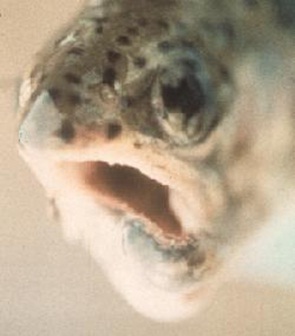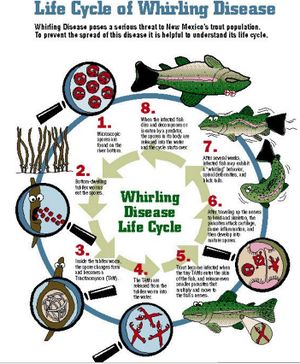Whirling Disease
From Glen Canyon Dam AMP
Whirling Disease is a concern in the Program because it can devastate rainbow trout populations and is easily transferred between waters.
- 1999: Annual surveillance began
- 2007: first positive detection (PCR)
- 2008-2010: no detection
- 2011: positive detection (histology)
Presentations:
- Whirling Disease Update PPT
- GCMRC Updates and Sediment Update PPT
- Whirling Disease Update PPT
- Whirling Disease Memo from Scott Vanderkooi to TWG Chair Dated Oct. 22, 2012 and PPT
- 121024_TWG_Whirling Disease AZ Game and Fish
- State of Colorado Parks and Wildlife- Whirling Disease and Colorado's Trout
- "Because the parasite causing the disease is water-borne, the AGFD has informed that the entire river, from Glen Canyon Dam to Lake Mead is considered to be infected. For this reason, AGFD advised that the best course of action to eliminate the risk of spreading the disease is to not remove and transport fish from any location in this segment."
CLIFF NOTE VERSION
- Whirling disease is a parasitic condition affecting fish, primarily rainbow trout.
- Young fish are at greatest risk.
- First observed in the United States around 1958.
- Larger infected fish generally don't die but are carriers of the disease.
- Warm-water fish such as bass, walleye and catfish are not affected.
- Currently, No practical cure to treat wild trout infected with the disease.
- Once the disease parasite is established in the wild, it can persist indefinitely
- SIGNS INCLUDE: Whirling behavior- Blackened tail -Skeletal deformities
- WD has been identified in 25 states (2009)
- Trout species only- rainbow trout: highly susceptible, brown trout: can carry parasite, but generally do not show clinical signs
- Trout become resistant after 4-8 months
- Not harmful to humans, trout in WD infected waters are ok to eat
- Spore are very resistant
- "It should be noted that although whirling disease can have a devastating effect on rainbow and cutthroat trout, the disease poses no threat to native fish species, including the humpback chub." NOTE: "...mobilzation of fine sediments may inhbit the spread of whirling disease in river systems; accordingly the HFE release may have a veneficial effect regarding the adverse effects of the disease. This is an area that will require further research in the future. (According to DOI MEMO_ Status of Implementation of HFE Program and Non-Native Fish Control at Glen Canyon Dam_121220)
- Reference to Whirling Disease_AMWG 2001 (pgs 27-29)

